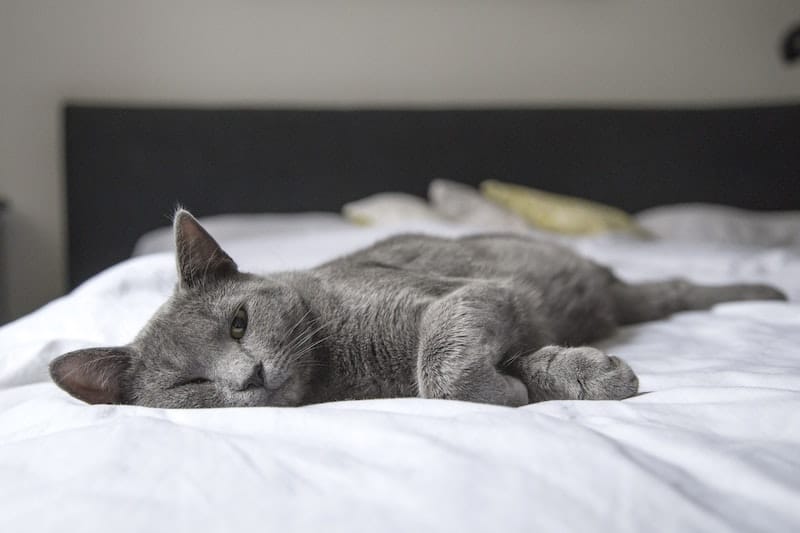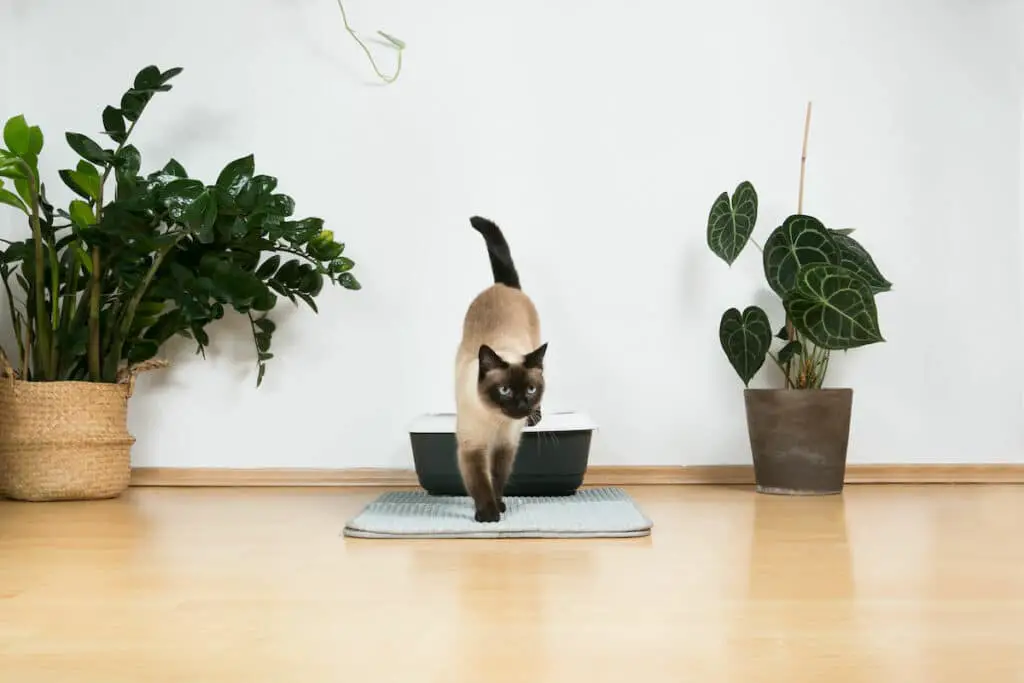If your cat is having difficulty urinating, it could be a sign of a medical condition known as feline lower urinary tract disease (FLUTD). This condition can be painful and uncomfortable for cats and can be caused by anything from stress to urinary crystals. Fortunately, there are a few home remedies you can try to help your cat pee normally. So if you’ve been googling “cat can’t pee home remedies”, fear not, we’ve gathered some at-home solutions you can try.
Note: If your cat is completely unable to pee, this is a total urinary obstruction and you must see a vet immediately.
Home Remedies
If your cat can’t pee, here are 13 home remedies that may help solve the problem.
1. Clean the litter box more often
Cleaning your cat’s litter box is essential to preventing urinary infections. Not only that, but it’s healthier for them overall and better for you and other pets.
2. Increase Water Intake
One of the most important things you can do for your cat is to ensure that he or she is drinking plenty of water. Offer fresh, clean water multiple times a day, and if you can, try to encourage your cat to drink from a fountain or a running tap.
3. Change Food
If your cat is not getting enough water from his or her food, it may be time to switch to a wet food diet. Wet food is higher in water content, which can help to keep your cat hydrated and aid in normal urination.
4. Stress Relief
Stress can be a major factor in FLUTD and can be difficult to identify. To reduce stress, provide your cat with plenty of hiding places, interactive toys, and a quiet spot to relax.
5. Massage
Massaging your cat’s lower abdomen can help to relieve tension in the bladder and encourage the flow of urine.
6. Parsley Leaf
As a diuretic, parsley leaf can help with waste removal. Additionally, the leaves are antiseptic.
7. Cranberry
Numerous healthy substances and vitamins can be found in cranberries.
8. Glucosamine
Glycosaminoglycans, a substance that lines the bladder wall, are replenished with the aid of glutamine (GAG).
9. Chondroitin
The GAG can be shielded against degradation by chondroitin.
10. Juniper Berry
Juniper berries work wonders in the treatment of UTIs. Infection is fought off by their antibacterial and antifungal qualities, and a volatile oil included in the berries aids in kidney filtering. The diuretic impact of the berries increases urine flow, which helps to flush out infection by dilution of the urine and bacterial cleaning. In addition, juniper berries have anti-inflammatory properties and can relieve pain from UTIs and bladder infections.
11. Marshmallow Root
The marshmallow plant’s root is immunostimulant, demulcent, emollient, antibacterial, and more. Additionally, it has diuretic properties that increase urine output.
12. Uva Ursi
Uva ursi leaf extracts have shown antibacterial efficacy against organisms that cause UTIs in in vitro investigations.
13. Apple Cider Vinegar
If your cat can’t pee and you’re looking for home remedies, apple cider vinegar might work. Within a few days, symptoms can be relieved by giving your cat a modest dosage of apple cider vinegar. For the correct dosage, speak with your veterinarian.

What Causes Urinary Obstruction In Cats?
Materials obstructing the cat’s urethra are the main cause of urinary obstructions in cats. But how those resources get there is a different matter. It can be challenging to pinpoint the cause of your cat’s issue because several things can lead to a blockage. The following are some typical causes of cat urinary problems:
Dry Food
If left alone, a cat will chase mice, lizards, and birds for food. About 75% of these prey animals are made up of water. Approximately 8% of dry food is water. In contrast to a cat’s natural diet, this represents a significant shortfall. A diet that is dehydrating causes the urine to become more concentrated, which increases the likelihood of mineral stones in the urine. Contrary to popular perception, magnesium-rich diets do not cause bladder stones as long as the pH of the urine is lower than 7.5.
Your cat’s diet will benefit from the addition of wet canned food to stop the formation of struvite crystals in the bladder. Since canned food contains more water than dry food, it will fully hydrate your cat. Their urine will be less concentrated as a result, which lowers the possibility of urinary obstructions forming.
Feline Idiopathic Cystitis (FIC)
The term “feline idiopathic cystitis” refers generally to bladder inflammation for which there is no known etiology. It causes a number of feline urinary tract issues, such as urinary obstructions. Cats with inflamed bladders produce more mucus, which increases their chance of developing urinary blockages. In turn, obstructions exacerbate bladder inflammation, which prolongs the problem. The endocrine and central nervous systems may be out of balance, yet the exact origin of FIC is uncertain.
Scar Tissue
Scar tissue can contribute to your cat’s urinary issues, even though it’s one of the less frequent causes of obstructions. Remaining scar tissue from prior injuries to the urinary tract can thicken the urethral wall and prevent urine from passing through, a condition known as urethral strictures. An operation known as a perineal urethrostomy (PU) can be used to cure this condition by giving your cat a new urine opening and allowing fluid to flow around the scar tissue.
How Do I Know If My Cat Has A Urinary Blockage?
It will be clear whether your cat has a urinary blockage. Sadly, this disease will probably cause your cat a lot of discomfort. Frequent excursions to the litter box without any pee are the most typical sign of a urinary obstruction. Your cat might yowl and wail in agony as it struggles to urinate. Additionally, your cat’s bladder will start to lose some control, which will lead to accidents where it normally wouldn’t urinate. For obvious reasons, this isn’t very pleasant, but it’s crucial not to disregard this conduct. Your cat may have a blockage or another urinary issue if it begins to urinate outside the litter box.
Symptoms of Urinary Blockage in Cats
The symptoms of a cat UTI can closely match those of a cat urinary obstruction. It’s crucial to keep a close eye on your cat’s behavior and look out for the following signs:
- Frequent trips to the litter box
- Urinating in places other than the litter box
- decreased urine output
- Blood in the urine
- Yowling or crying (during urination or otherwise)
- Vomiting
- Decreased appetite
- Lethargy
- Excessive licking of the genital region
- Abdominal pain
When To Go To The Vet For Cat Urinary Obstruction
If your cat can’t pee and you’re looking for home remedies, keep in mind the obstruction might be more severe than you think. You should visit the vet as soon as you suspect your cat has a blockage. Keep in mind that affected cats require specialized medical care as this ailment poses a risk to their lives. The accumulation of urine will result in the rupture of the kidneys, and the electrolyte imbalance brought on by decreased urine output can result in heart failure. The best care for your cat will be provided by your neighborhood vet.
FAQs: Cat can’t pee home remedies
When it comes to cats and urinating, the answer to this question can be complicated. A cat’s bladder is much smaller than a human’s and can only hold a small amount of urine for a short period of time. That being said, a cat can typically go anywhere from twelve to twenty-four hours without urinating.
It is important to note that some cats can hold their urine longer than others, and some cats will urinate more frequently than others. If your cat seems to be urinating more or less often than usual, it is always best to consult your veterinarian.
In addition, cats can become dehydrated quickly if they are not drinking enough water. This can lead to a decrease in the amount of urine they are producing, which can increase the amount of time they can go without urinating. It is important to ensure that your cat has access to plenty of fresh water throughout the day to prevent this from happening.
Finally, if your cat is having difficulty urinating, it is important to seek veterinary attention immediately. Urinary problems can be a sign of a serious health issue and require prompt medical attention.
When it comes to cat urinary blockages, it’s important to act fast and seek medical attention for your pet. While it is possible for a cat urinary blockage to resolve itself, it is highly unlikely and can be dangerous for your pet’s health.
A cat urinary blockage is caused when the urethra (the tube that carries urine from the bladder to the outside of the body) becomes blocked. This blockage prevents the cat from urinating, which can cause a buildup of toxins in the bloodstream and can lead to a medical emergency.
If left untreated, a cat urinary blockage can be fatal. That’s why it’s so important to seek medical attention as soon as possible. Unfortunately, a cat urinary blockage cannot resolve itself and must be treated by a veterinarian.
If your cat is diagnosed with a urinary blockage, your veterinarian will likely prescribe medication to help relax the muscles of the urinary tract and help your cat pass the blockage. The veterinarian may also perform a surgery to remove the blockage or insert a urinary catheter to help the cat urinate.
A cat’s bladder needs to be stimulated regularly in order to help prevent urinary tract infections, crystals, and other health issues. Unstimulated bladders can become stagnant and can cause a cat to strain when trying to urinate. This can lead to further bladder and urinary tract complications.
To stimulate a cat’s bladder, there are a few things you can do. First, make sure your cat has plenty of water to drink throughout the day. This helps keep your cat’s bladder full and encourages regular urination. You can also try to get your cat to exercise more. This can be done by playing with them or taking them on walks. Exercise helps move the urine through the bladder and prevents stagnation.
Additionally, you can try to give your cat a massage. Gently massaging the bladder area can help get the urine moving and stimulate the bladder. This can be done with your hands or a soft brush.
Female cats are more likely than male cats to have a UTI. However, UTIs can also cause major difficulties in male cats. The tiny urethras of male cats are susceptible to blockage, which can be fatal. Bacteria that develop in the bladder can cause urinary tract infections. Although some bladder infections and UTIs go undetected, most of them result in physical discomfort.
The amount of time it takes to unblock a cat’s urethra depends on the severity of the blockage. If the blockage is mild, the vet may be able to simply flush the urethra with a saline solution and the obstruction will be gone. If the blockage is more severe, the vet may need to perform a procedure such as a cystotomy, which requires anesthesia and can take several hours.
In some cases, the vet may need to use a stent to open the urethra and remove the obstruction. The stent is inserted into the urethra and it can take several days for the stent to work and open the urethra.
If the blockage is particularly severe, the vet may need to perform surgery to remove the obstruction. This procedure can take several hours and may require your cat to stay in the hospital for a few days.














